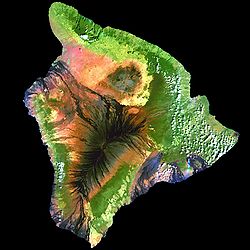Landsat program
From Wikipedia, the free encyclopedia

The Landsat program is the longest running enterprise for acquisition of imagery of Earth from space. The first Landsat satellite was launched in 1972; the most recent, Landsat 7, was launched on April 15, 1999. The instruments on the Landsat satellites have acquired millions of images. The images, archived in the United States and at Landsat receiving stations around the world, are a unique resource for global change research and applications in agriculture, cartography, geology, forestry, regional planning, surveillance, education and national security. Landsat 7 data has eight spectral bands with spatial resolutions ranging from 15 to 60 meters.
Contents[hide] |
[edit] History
Hughes Santa Barbara Research Center initiated design and fabrication of the first three MSS Multi-Spectral-Scanners in the same year man landed on the moon, 1969. The first prototype MSS was completed within nine months by fall of 1970 when it was tested by scanning Half Dome at Yosemite National Park.
The initial centerline for the primary layout of the MSS was drawn by Jim Kodak, the opto-mechanical design engineer who designed the Pioneer spacecraft optical camera, the first instrument to leave the solar system.
The program was called the Earth Resources Observation Satellites Program when it was initiated in 1966, but the name was changed to Landsat in 1975. In 1979, Presidential Directive 54 under President of the United States Jimmy Carter transferred Landsat operations from NASA to NOAA, recommended development of long term operational system with four additional satellites beyond Landsat 3, and recommended transition to private sector operation of Landsat. This occurred in 1985 when the Earth Observation Satellite Company (EOSAT), a partnership of Hughes Aircraft and RCA, was selected by NOAA to operate the Landsat system under a ten year contract. EOSAT operated Landsats 4 and 5, had exclusive rights to market Landsat data, and was to build Landsats 6 and 7.

In 1989, this transition had not been fully completed when NOAA's funding for the Landsat program ran out and NOAA directed that Landsats 4 and 5 be shut down, but an act of the United States Congress provided emergency funding for the rest of the year. Funding ran out again in 1990 and once again Congress provided emergency funding to NOAA for six more months of operations, requesting that agencies that used Landsat data provide the funding for the other six months of the upcoming year. The same funding problem and solution was repeated in 1991. In 1992, various efforts were made to finally procure funding for follow on Landsats and continued operations, but by the end of the year EOSAT ceased processing Landsat data. Landsat 6 was finally launched on October 5, 1993, but was lost in a launch failure. Processing of Landsat 4 and 5 data was resumed by EOSAT in 1994. NASA finally launched Landsat 7 on April 15, 1999.
The value of the Landsat program was recognized by Congress in October 1992 when it passed the Land Remote Sensing Policy Act (Public Law 102-555) authorizing the procurement of Landsat 7 and assuring the continued availability of Landsat digital data and images, at the lowest possible cost, to traditional and new users of the data.
[edit] Satellite chronology
- Landsat 1 (originally named Earth Resources Technology Satellite 1) - launched July 23, 1972, terminated operations in 1978
- Landsat 2 - launched January 22, 1975, terminated in 1981
- Landsat 3 - launched March 5, 1978, terminated 1983
- Landsat 4 - launched July 16, 1982, terminated 1993
- Landsat 5 - launched March 1, 1984, still functioning. [1] [2]
- Landsat 6 - launched October 5, 1993, failed to reach orbit
- Landsat 7 - launched April 15, 1999, still functioning, but with faulty scan line corrector (May 2003) [3]
[edit] Technical details

The Multi-Spectral-Scanner had a 9" fused silica dinner-plate mirror epoxy bonded to three invar tangent bars mounted to base of a Ni/ Au brazed Invar frame in a serreuire truss that was arranged with four "Hobbs-Links" (conceived by Dr. Gregg Hobbs) crossing at mid truss. This construct ensured the secondary mirror would simply oscillate about the primary optic axis to maintain focus despite vibration inherent from the 14-inch (360 mm) Be scan mirror. This engineering solution allowed the US to develop LANDSAT at least five years ahead of French SPOT which first used CCD arrays to stare without need for a scanner.
The MSS FPA, or Focal Plane Array consisted of 24 square optical fibers extruded down to .0002"square fiber tips in a 4x6 array to be scanned across the Nimbus spacecraft path in a +/-6 degree scan as the satellite was in a 10:30 polar orbit, hence it had to be launched from Vandenburg AFB. The fiber optic bundle was embedded in a fiber optic plate to be terminated at a relay optic device that transmitted fiber end signal on into six photodiodes and 18 photomultiplier tubes that were arrayed across a 0.30-inch (7.6 mm) thick aluminum tool plate, with sensor weight balanced vs the 9-inch (230 mm) telescope on opposite side. This main plate was assembled on a frame, then attached to the silver-loaded magnesium housing with helicoil fasteners.
Key to MSS success was the scan monitor mounted on the underbelly of the Mg housing. It consisted of a diode source & sensor mounted at ends of four flat mirrors that were tilted so that it took 14 bounces for a beam to reflect length of the three mirrors from source to sender striking Be scan mirror seven times as it reflected seven times off the flat mirrors. It only sensed three positions, both ends of scan & the mid scan, but that was all that was required to determine where MSS was pointed and electronics scanning could be calibrated to display a map.
No comments:
Post a Comment